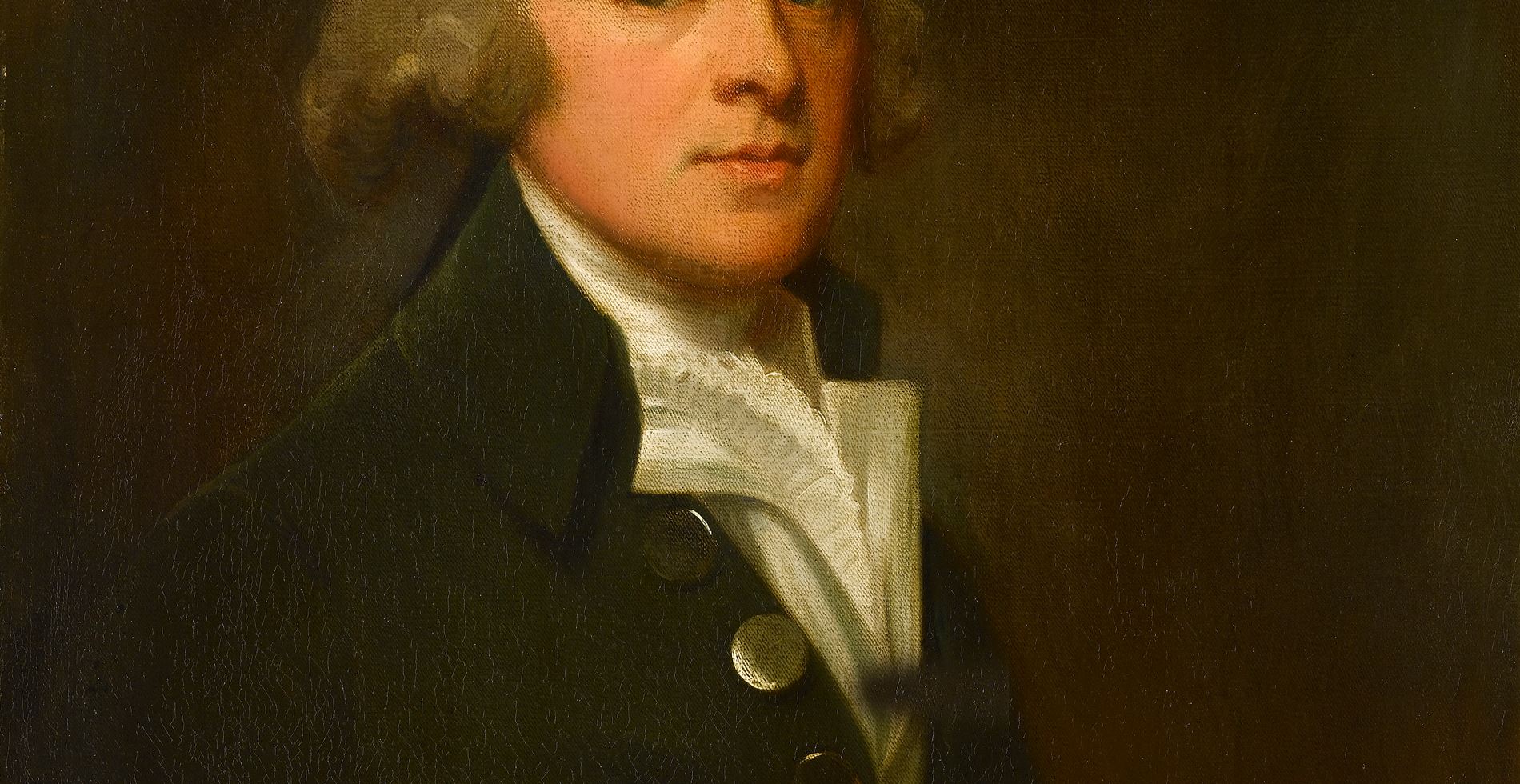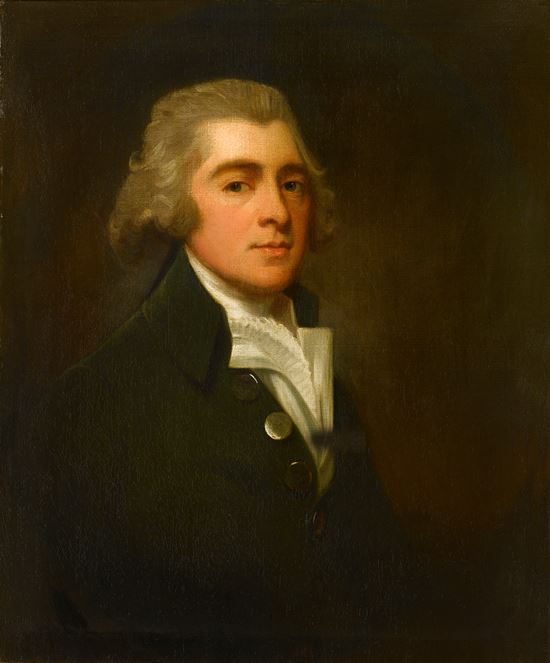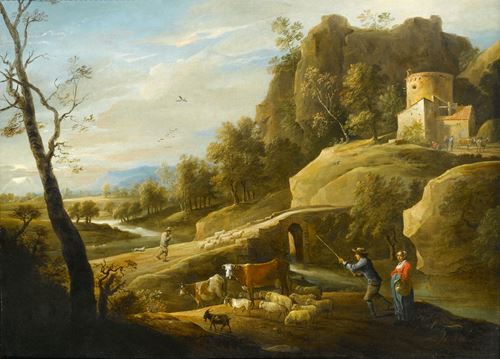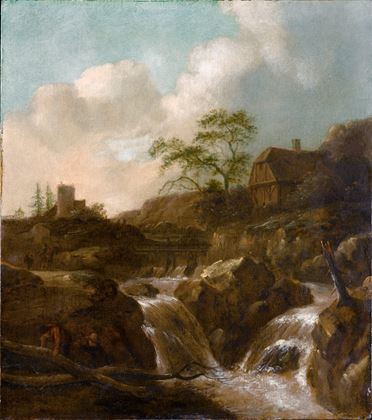eorge Romney
(Dalton 1734 - Kendal 1802)
Portrait of a Gentleman, Half-Length, Wearing a Dark Coat and White Stock
oil on canvas
76.2 x 63.5 cm (30 x 25 in)
Throughout the second half of the eighteenth century, George Romney was one of the most sought-after portraitists in Britain, though his portraits were not quite as dear as those by Joshua Reynolds and Thomas Gainsborough he was nevertheless recognised as their only rival. In fact, as he was more inclined to Neoclassicism than many of his British contemporaries, at the height of his career Romney was the most fashionable portraitist in British society, with his sitters always appearing elegant and beautiful.
In Portrait of a Gentleman, Half-Length, Wearing a Dark Coat and White Stock one can see why Romney’s services were so in demand. The gentleman sits, half turned towards the viewer, meeting our gaze calmly and confidently. His face is idealised, soft and unblemished, with his hair brushed back from his forehead, as was the fashion. His clothing is simple and fashionable and tells the viewer that we are looking at a tasteful, elegant and refined individual. By using such a dark, stark background, Romney focuses our attention onto his subject.
English portraiture flourished in the late eighteenth century, when not only aristocrats, but also lesser nobles, merchants and officers commissioned portraits of themselves, their wives and children. Therefore, in many of the portraits of the time we see not only the most important public figures, but also the lesser known characters from British society who still wished to have their portraits painted. Portrait of a Gentleman, Half-Length, Wearing a Dark Coat and White Stock reflects this trend, and commissions similar to it are typical of much of Romney’s work.
The present work is comparable to many of Romney’s portraits, such as the Tate’s William Pitt the Younger. Neither work seeks to give an insight into the sitter’s character or occupation, rather they are idealised likenesses, intended to flatter. In this sense Romney was an ideal fashionable portrait painter because, as Sir Ellis Waterhouse wrote in Painting in Britain 1530-1790, he delighted in rendering ‘all those neutral qualities which are valued by Society – health, youth, good looks, an air of breeding’.¹
Romney was born, trained, and began his career in the north of England before moving to London in 1762, where he exhibited at the Society of Arts and later at the Free Society and the Society of Artists. Romney may have been a prolific portrait painter, with over a thousand canvases scattered in private and public collections around the world, but he aspired to be a history painter. However, working for members of high society was far too financially profitable to ignore. In 1775 he charged fifteen guineas for a head and shoulders but by 1793 this had risen to thirty five guineas, his fees for half lengths were double these, and for full lengths double again. As a result, Romney's own successes as a history painter were limited, but he made many hundreds of pen and wash drawings illustrating subjects from the classics, Shakespeare, and Milton.
Romney was by nature sensitive and introspective. He held himself aloof from the Royal Academy and his fellow artists, making his friends in philosophical and literary circles. In 1782 he met Emma Hart (later Lady Hamilton), who exercised a morbid fascination over him. His ‘divine Emma’ appears in more than 50 paintings, in guises ranging from a bacchante to Joan of Arc. Almost all were painted from memory. Today he is remembered as one of the most significant portrait painters of his generation.
¹ Waterhouse, E., Painting in Britain 1530-1790, (Penguin, London, 1953) p. 222.
with Asscher & Welker, London 1936;
Wayne MacFarlane;
with Agnew's London, 1976;
private collection New York and by descent to the previous owner.
Alex Kidson, George Romney: A Complete Catalogue of his Paintings (Yale University Press, 2015), vol.iii, p.711, cat no.1545.
Master Paintings Recent Acquisitions, Agnew's, May 18 - June 18 1976, no. 50.
Throughout the second half of the eighteenth century, George Romney was one of the most sought-after portraitists in Britain, though his portraits were not quite as dear as those by Joshua Reynolds and Thomas Gainsborough he was nevertheless recognised as their only rival. In fact, as he was more inclined to Neoclassicism than many of his British contemporaries, at the height of his career Romney was the most fashionable portraitist in British society, with his sitters always appearing elegant and beautiful.
In Portrait of a Gentleman, Half-Length, Wearing a Dark Coat and White Stock one can see why Romney’s services were so in demand. The gentleman sits, half turned towards the viewer, meeting our gaze calmly and confidently. His face is idealised, soft and unblemished, with his hair brushed back from his forehead, as was the fashion. His clothing is simple and fashionable and tells the viewer that we are looking at a tasteful, elegant and refined individual. By using such a dark, stark background, Romney focuses our attention onto his subject.
English portraiture flourished in the late eighteenth century, when not only aristocrats, but also lesser nobles, merchants and officers commissioned portraits of themselves, their wives and children. Therefore, in many of the portraits of the time we see not only the most important public figures, but also the lesser known characters from British society who still wished to have their portraits painted. Portrait of a Gentleman, Half-Length, Wearing a Dark Coat and White Stock reflects this trend, and commissions similar to it are typical of much of Romney’s work.
The present work is comparable to many of Romney’s portraits, such as the Tate’s William Pitt the Younger. Neither work seeks to give an insight into the sitter’s character or occupation, rather they are idealised likenesses, intended to flatter. In this sense Romney was an ideal fashionable portrait painter because, as Sir Ellis Waterhouse wrote in Painting in Britain 1530-1790, he delighted in rendering ‘all those neutral qualities which are valued by Society – health, youth, good looks, an air of breeding’.¹
Romney was born, trained, and began his career in the north of England before moving to London in 1762, where he exhibited at the Society of Arts and later at the Free Society and the Society of Artists. Romney may have been a prolific portrait painter, with over a thousand canvases scattered in private and public collections around the world, but he aspired to be a history painter. However, working for members of high society was far too financially profitable to ignore. In 1775 he charged fifteen guineas for a head and shoulders but by 1793 this had risen to thirty five guineas, his fees for half lengths were double these, and for full lengths double again. As a result, Romney's own successes as a history painter were limited, but he made many hundreds of pen and wash drawings illustrating subjects from the classics, Shakespeare, and Milton.
Romney was by nature sensitive and introspective. He held himself aloof from the Royal Academy and his fellow artists, making his friends in philosophical and literary circles. In 1782 he met Emma Hart (later Lady Hamilton), who exercised a morbid fascination over him. His ‘divine Emma’ appears in more than 50 paintings, in guises ranging from a bacchante to Joan of Arc. Almost all were painted from memory. Today he is remembered as one of the most significant portrait painters of his generation.
¹ Waterhouse, E., Painting in Britain 1530-1790, (Penguin, London, 1953) p. 222.
with Asscher & Welker, London 1936;
Wayne MacFarlane;
with Agnew's London, 1976;
private collection New York and by descent to the previous owner.
Alex Kidson, George Romney: A Complete Catalogue of his Paintings (Yale University Press, 2015), vol.iii, p.711, cat no.1545.
Master Paintings Recent Acquisitions, Agnew's, May 18 - June 18 1976, no. 50.





 contact
contact +44 20 7313 8040
+44 20 7313 8040









